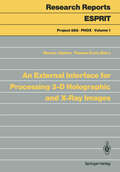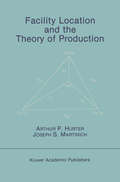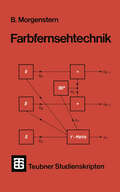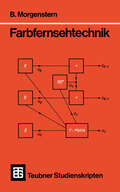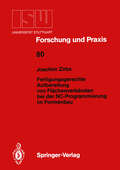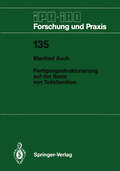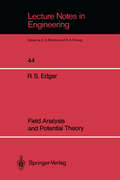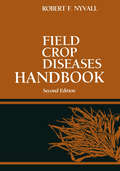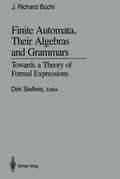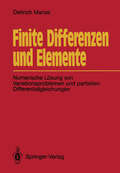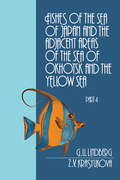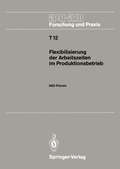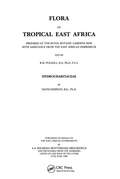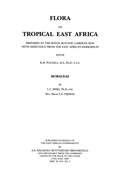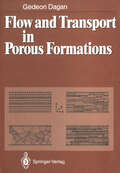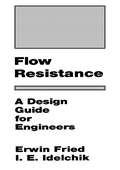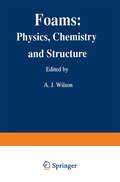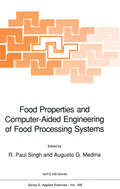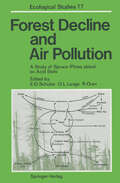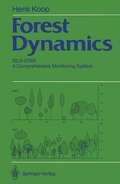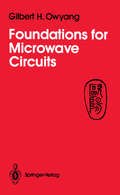- Table View
- List View
An External Interface for Processing 3-D Holographic and X-Ray Images (Research Reports Esprit #1)
by Werner Jüptner Thomas KreisInternationally recognized experts in the field of holographic interferometric testing, X-ray testing, and structural analysis by finite element techniques have come together in ESPRIT project 898 to develop a system that integrates these techniques. This system acts as an external interface between the complementary nondestructive testing methods and computer based structural analysis. In the book the testing and analysis techniques are presented and compared with special emphasis on problems regarding their combination and integration. The architecture and the components of the interface system are described. Experiments proving the feasibility and applicability of the concepts are presented. The chapters of the book dealing with the different techniques are written by the individual partners of the project. A common test object is investigated by all techniques. The book helps the customer to select the testing and analysis method most suitable for his problem. It also presents the background for building up integrated testing equipment for analysis and control.
Facility Location and the Theory of Production
by Arthur P. Hurter Joseph S. MartinichThe design and location of production facilities are important aspects of corporate strategy which can have a significant impact on the socio economy of nations and regions. Here, these decisions are recognized as being interrelated; that is, the optimal plant design (input mix and output level) depends on the location of the plant, and the optimal location of the plant depends on the design of the plant. Until the late 1950s, however, the questions of where a firm should locate its plant and what should be its planned input mix and output level were treated, for the most part, as separate questions, and were investigated by different groups of research ers. Although there was some recognition that these questions are inter I 1928; Hoover 1948; Isard 1956], no detailed analysis related [e. g. , Pre doh or formal structure was developed combining these two problems until the work of Moses [1958]. In recent years scholarly interest in the integrated production/locaton decision has been increasing rapidly. At the same time that research on the integrated production/location problem was expanding, significant related work was occurring in the fields of operations research, transportation science, industrial engineering, eco nomics, and geography. Unfortunately, the regional scientists working on the production/location problem had little contact with researchers in other fields. They generally publish in different journals and attend dif ferent professional meetings. Consequently, little of the recent work in these fields has made its way into the production/location research and vice versa.
Fertigungsgerechte Aufbereitung von Flächenverbänden bei der NC-Programmierung im Formenbau (ISW Forschung und Praxis #80)
by Joachim ZirbsFertigungsstrukturierung auf der Basis von Teilefamilien (IPA-IAO - Forschung und Praxis #135)
by Manfred AuchDieser Band behandelt die Gliederung einer Fertigung in teilautonome Einheiten. Der Autor geht dabei vom Gedanken der Gruppentechnologie aus. Das Teilespektrum wird zu Teilefamilien gruppiert, die für die Bearbeitung benötigten Maschinen werden bestimmt und in einer räumlichen Einheit angeordnet, so daß die Teile möglichst komplett vom ersten bis zum letzten Arbeitsgang innerhalb dieser Einheit gefertigt werden können. Auf diese Weise sollen Durchlaufzeiten verkürzt, Bestände reduziert und die Termintreue verbessert werden. Es wird ein Verfahren entwickelt, das in der Lage ist, das gesamte Teilespektrum eines Unternehmens zu gliedern. Basis dafür ist im wesentlichen die Analyse der Arbeitspläne des Unternehmens, das Instrument die schnelle Clusteranalyse. Im praktischen Einsatz des Verfahrens wird demonstriert, wie sich auf der Basis der Teilefamilien-Gliederung unterschiedliche Fertigungsstrukturierungs-Alternativen ableiten lassen.
Field Analysis and Potential Theory (Lecture Notes in Engineering #44)
by Robert S. Edgar"Electromagnetic theory is a peculiar subject. The peculiarity resides not so much in the stratification - superposed layers of electrostatics. magnetostatics. steady currents and time-varying fields - as in the failure that has attended all attempts to weld these layers into a logical whole. The lowest layer. electrostatics. defines certain concepts. such as E. D, ~, in a way that is generally satisfactory only for the static case. Yet the attempt is made to force these specialised definitions into the higher strata, with ad hoc modifications when necessary. The student, in looking through his text books on electromagnetics, can find general definitions only with difficulty. if at all; and even the most advanced treatises fail to present a rigorously logical development of the subject". 1 So wrote Moon and Spencer some 30 years ago; and their criticism continues to be pertinent today. 2 More recently. a senior physicist of the National Bureau of Standards has expressed his concern in similar terms: "A logically consistent set of definitions of the electromagnetic field quantities is extremely difficult to find in the literature. Most text books either evade the problem or present definitions that are applicable only to special cases".
Field Crop Diseases Handbook (PDF)
by Robert F. NyvallA text and reference for students and professionals, this volume discusses the causes, distribution, symptoms, and control of the diseases of many of the world's important field crops.
Finite Automata, Their Algebras and Grammars: Towards a Theory of Formal Expressions
by J. Richard BüchiThe author, who died in 1984, is well-known both as a person and through his research in mathematical logic and theoretical computer science. In the first part of the book he presents the new classical theory of finite automata as unary algebras which he himself invented about 30 years ago. Many results, like his work on structure lattices or his characterization of regular sets by generalized regular rules, are unknown to a wider audience. In the second part of the book he extends the theory to general (non-unary, many-sorted) algebras, term rewriting systems, tree automata, and pushdown automata. Essentially Büchi worked independent of other rersearch, following a novel and stimulating approach. He aimed for a mathematical theory of terms, but could not finish the book. Many of the results are known by now, but to work further along this line presents a challenging research program on the borderline between universal algebra, term rewriting systems, and automata theory. For the whole book and again within each chapter the author starts at an elementary level, giving careful explanations and numerous examples and exercises, and then leads up to the research level. In this way he covers the basic theory as well as many nonstandard subjects. Thus the book serves as a textbook for both the beginner and the advances student, and also as a rich source for the expert.
Finite Differenzen und Elemente: Numerische Lösung von Variationsproblemen und partiellen Differentialgleichungen
by Dietrich MarsalDas vorliegende Werk ist ein Lehr- und Arbeitsbuch für den Selbstunterricht, für die Rechenpraxis und für Übungen. Es richtet sich an jeden Interessierten, mag er Physiker oder Ingenieur, Analytiker oder Numeriker, Chemiker oder Geowissenschaftler sein, mag er große oder geringe Vorkenntnisse besitzen. Im Teil über finite Differenzen soll der Leser von einfachsten Aufgaben bis hin zu komplexen Problemen und Techniken (numerische Dispersion, upstream-weighting, Vorkonditionierung von Gleichungssystemen usw.) geführt werden, und zwar von der analytischen Fassung der Aufgabe bis zum fertigen, knappen, für dieses Buch entwickelten Programm (in Fortran 77 geschrieben). Der Teil über finite Elemente setzt keine Strukturmechanik voraus. Er spricht Leser an, die finite Elemente als Alternative zu finiten Differenzen betrachten und nur Kenntnisse aus der Differential- und Integralrechnung mehrerer Variablen mitbringen. Deshalb wird die Finite-Element-Methode in einfacher Weise aus dem Grundgedanken des Ritzschen Prinzips entwickelt, und zwar von der Differentialgleichung über die zugehörige Variationsaufgabe zum algebraischen Gesamtgleichungssystem.
Fishes of the Sea of Japan and the Adjacent Areas of the Sea of Okhotsk and the Yellow Sea
by G.U. LindbergThis part completes the review of the largest and economically richest order of fishes, Perciformes, begun in Part 3. It includes 12 suborders with keys and brief descriptions to 230 species, and information on their ecology and distribution.
Fishes of the Sea of Japan and the Adjacent Areas of the Sea of Okhotsk and the Yellow Sea
by G.U. LindbergThis part completes the review of the largest and economically richest order of fishes, Perciformes, begun in Part 3. It includes 12 suborders with keys and brief descriptions to 230 species, and information on their ecology and distribution.
Flexibilisierung der Arbeitszeiten im Produktionsbetrieb: IAO-Forum 9. November 1988 in Stuttgart (IPA-IAO - Forschung und Praxis Tagungsberichte #12)
by Hans-Jörg BullingerArbeitszeit ist keine einheitlich vorgegebene starre Größe mehr. Dauer und Lage der Arbeitszeit können unterschiedlich und beweglich gestaltet werden. Das schafft die Möglichkeit, die jeweiligen Erfordernisse des einzelnen Unternehmens, aber auch die ebenfalls nicht einheitlichen Interessen der Arbeitnehmer zu berücksichtigen. Neue Technologien sowie veränderte Marktanforderungen stellen an die Arbeitsorganisation und Arbeitsgestaltung der Produktionsbetriebe neue Aufgaben. Der Arbeitszeitgestaltung kommt hierbei eine nicht zu unterschätzende Bedeutung zu. Eine Vielzahl von Faktoren ist bei der Planung und Einführung neuer Arbeitszeitsysteme zu berücksichtigen, beispielsweise die Laufzeit der Maschinen, der Zuwachs an bedienerloser Maschinenzeit, die Schwankungen der Auftragsvolumina, der zunehmende Konkurrenzdruck, die Entwicklung der Personalkosten und das Bedürfnis der Mitarbeiter nach mehr Zeitsouveränität. Der vorliegende Band ist den zentralen Fragestellungen der Planung und Umsetzung flexibler Arbeitszeitmodelle gewidmet. Wissenschaftler und betriebliche Experten stellen ihre Erkenntnisse und Erfahrungen vor und erläutern vor allem die betriebswirtschaftlichen und rechtlichen Aspekte der Flexibilisierung der Arbeitszeiten im Produktionsbetrieb.
Flora of Tropical East Africa - Hydrocharitaceae (1989)
by R.M. PolhillThis book is a comprehensive review of the genera of Hydrocharitaceae, a flowering plant family, found in tropical East Africa. It presents information on their character, occurrence, habitat, phenotypic variations and distribution of each of the species under these genera.
Flora of Tropical East Africa - Hydrocharitaceae (1989)
by R.M. PolhillThis book is a comprehensive review of the genera of Hydrocharitaceae, a flowering plant family, found in tropical East Africa. It presents information on their character, occurrence, habitat, phenotypic variations and distribution of each of the species under these genera.
Flora of Tropical East Africa - Moraceae (1989)
by R. M. PolhillThis book is a comprehensive review of the genera of Moraceae, a family of flowering plants, found in the tropical region of East Africa. It presents information on their character, occurrence, habitat, phenotypic variations and distribution of each of the species under these genera.
Flora of Tropical East Africa - Moraceae (1989)
by R.M. POLHILL, B.A., Ph.D., F.L.S.; C.C. BERG, Ph.D.; Mrs. Maria E.E. HIJMANThis book is a comprehensive review of the genera of Moraceae, a family of flowering plants, found in the tropical region of East Africa. It presents information on their character, occurrence, habitat, phenotypic variations and distribution of each of the species under these genera.
Flow and Transport in Porous Formations
by Gedeon DaganIn the mid-seventies, a new area of research has emerged in subsurface hydrology, namely sto chastic modeling of flow and transport. This development has been motivated by the recognition of the ubiquitous presence of heterogeneities in natural formations and of their effect upon transport and flow, on the one hand, and by the vast expansion of computational capability provided by elec tronic machines, on the other. Apart from this, one of the areas in which spatial variability of for mation properties plays a cardinal role is of contaminant transport, a subject of growing interest and concern. I have been quite fortunate to be engaged in research in this area from its inception and to wit ness the rapid growth of the community and of the literature on spatial variability and its impact upon subsurface hydrology. In view of this increasing interest, I decided a few years ago that it would be useful to present the subject in a systematic and comprehensive manner in order to help those who wish to engage themselves in research or application of this new field. I viewed as my primary task to analyze the large scale heterogeneity of aquifers and its effect, presuming that the reader already possesses a background in traditional hydrology. This is achieved in Parts 3, 4 and 5 of the text which incorporate the pertinent material.
Flow Resistance: Design Guide For Engineers
by I.E. IdelchikA sourcebook offering an up-to-date perspective on a variety of topics and using practical, applications-oriented data necessary for the design and evaluation of internal fluid system pressure losses. It has been prepared for the practicing engineer who understands fluid-flow fundamentals.
Flow Resistance: A Design Guide for Engineers
by I.E. IdelchikA sourcebook offering an up-to-date perspective on a variety of topics and using practical, applications-oriented data necessary for the design and evaluation of internal fluid system pressure losses. It has been prepared for the practicing engineer who understands fluid-flow fundamentals.
Foams: Physics, Chemistry and Structure (Springer Series in Applied Biology)
by Ashley J. WilsonFoams and froths are an important feature of everyday life; one only has to think of shaving foam, foam upholstery, fire fighting foam, bread, bear head, and ice cream. Less obvious but equally important are the foams and foaming processes which are being exploited in ever more complex and imaginative ways in industry. However, the unusual nature of foams, the fact that they are neither solids or liquids, and their very fragility has prevented scientists from obtaining a thorough understanding of even the basic principles of foam formation and stability. This volume presents papers on the physics, chemistry, structure and ultrastructure of foams by contributors from a wide range of backgrounds and research disciplines. The aim of the book is to present a unique multi-disciplinary cross section of work currently being undertaken on the subject of foams.
Food Properties and Computer-Aided Engineering of Food Processing Systems (NATO Science Series E: #168)
by R. P. Singh Augusto G. MedinaFood properties, whether they concern the physical, thermodynamic, chemical, nutritional or sensory characteristics of foods, play an important role in food processing. In our quest to gain a mechanistic understanding of changes occurring during food processing, the knowledge of food properties is essential. Quantitative information on the food properties is necessary in the design and operation of food processing equipment. Foods, because of their biological nature and variability, vary in the magnitude of their properties. The variation in properties offer a challenge both in their measurement and use in the food processing applications. Often a high level of precision in measurement of properties is not possible as the measurement method may itself cause changes to the product, resulting in a variation in the obtained values. Recognizing the difficulties in measurement of food properties, and the lack of completeness of such information, several research programs have been in existence during the last two decades. In Europe, a multinational effort has been underway since 1978. The first project supported by COST (European Cooperation in the Field of Scientific and Technical Research), was titled COST 90 "The Effect of Processing on the Physical Properties of Foodstuffs". This and another project COST 90bis have considerably added to our knowledge of measurement methods and data on a number of physical properties. Two publications that summarize the work conducted under 1 2 these projects are Physical Properties of Foods and Physical Properties of Foods .
Forest Decline and Air Pollution: A Study of Spruce (Picea abies) on Acid Soils (Ecological Studies #77)
by Roswitha AscheDuring the last decade, forest decline has become increasingly apparent. The decline in forest health was often reported to be associated with air pollution. The present study on Norway spruce stands in the Fichtelgebirge analyses various processes interacting within forest ecosystems. It covers transport and deposition of air pollutants, the direct effects of pollutants on above-ground plant parts, the responses of soil to acid rain, and the changing nutrient availability, and the accompanying effects on plant metabolism and growth. The role of fungi, microorganisms and soil animals in the decline of these stands is also assessed. The volume is concluded with a synthesis evaluation of the influence of different factors, and their interactions on forest decline.
Forest Dynamics: SILVI-STAR: A Comprehensive Monitoring System
by Henk KoopNo matter what forests are used for, forest managers have to deal with interactions between individual trees and between trees and other forest organisms. To understand these interactions, long-term monitoring of spontaneous forest development is necessary. A complete monitoring system has been developed including a computer package for analysis of long-term observation of forest dynamics. The system's name, "SILVI-STAR", is an acronym of SILVIgenesis and Single-tree Three-dimensional Architecture. A method of nested plot data collection on forest architecture and plant species composition has been developed out for monitoring purposes.
Foundations for Microwave Circuits
by Gilbert H. OwyangWhile many articles have been written on microwave devices, a great majority of them are prepared for specialists dealing in specific aspects of microwave engineering. At the same time, material at a fundamental level in tutorial form is extremely limited, especially for stu dents who need to acquire basic knowledge in the field. Individuals seeking to gain a prelim inary understanding of microwave circuits are usually relegated with little success to the end less search from one reference source to another. For non-experts, sequential derivations of basic relations are rarely available and extremely difficult to locate. The purpose of this volume is to collect in one place the essential fundamental principles for a group of microwave devices. The chosen devices are those which form the basic modules found in practical microwave systems. Thus, these devices provide the crucial build ing blocks in common microwave systems, and their inherent characteristics are also the basis of some of the fundamental concepts in more complex devices. The material is presented in a continuous, self-contained manner. With the appropriate background, readers should be able to follow and understand the contents without the need for additional references.
